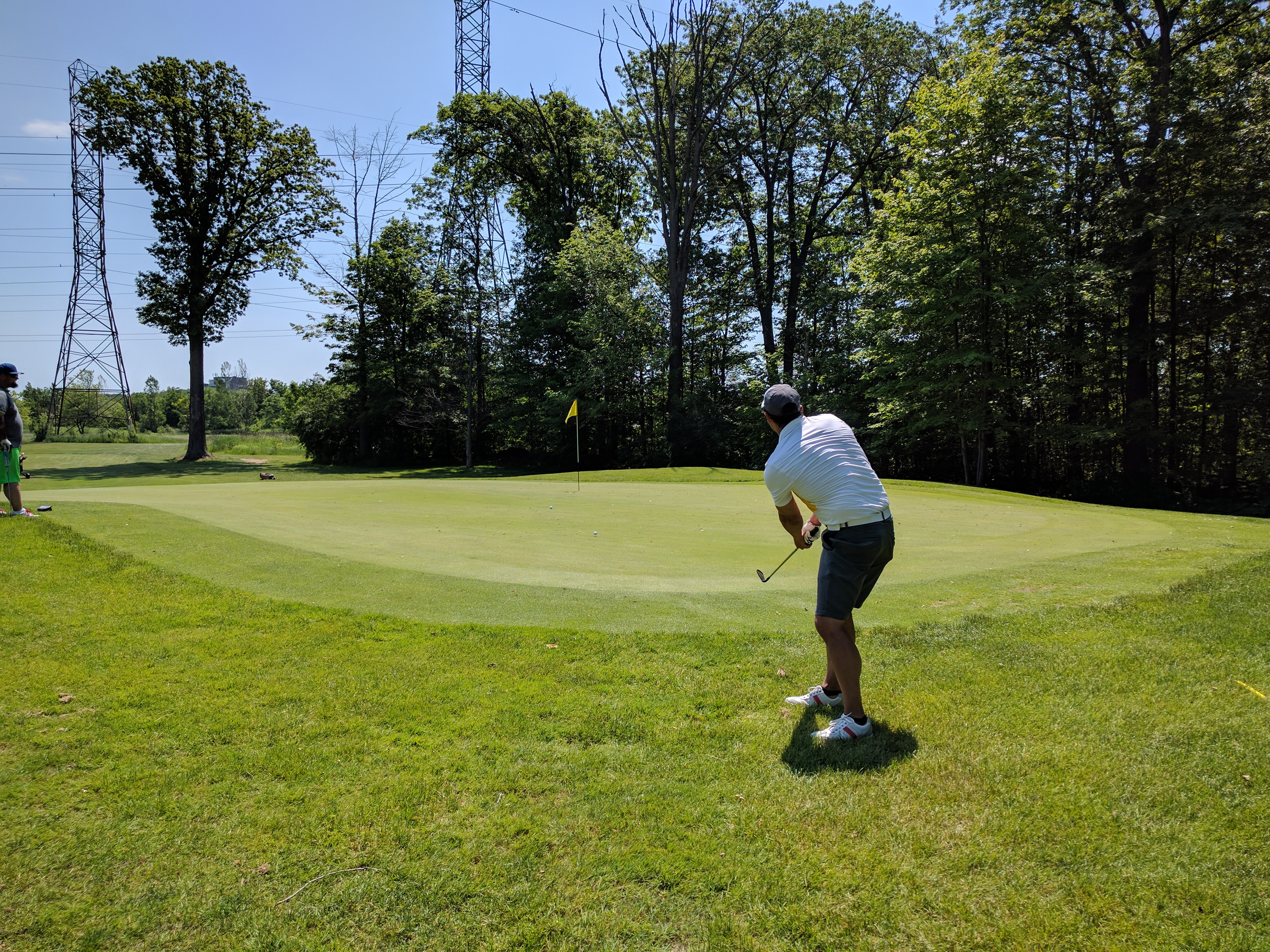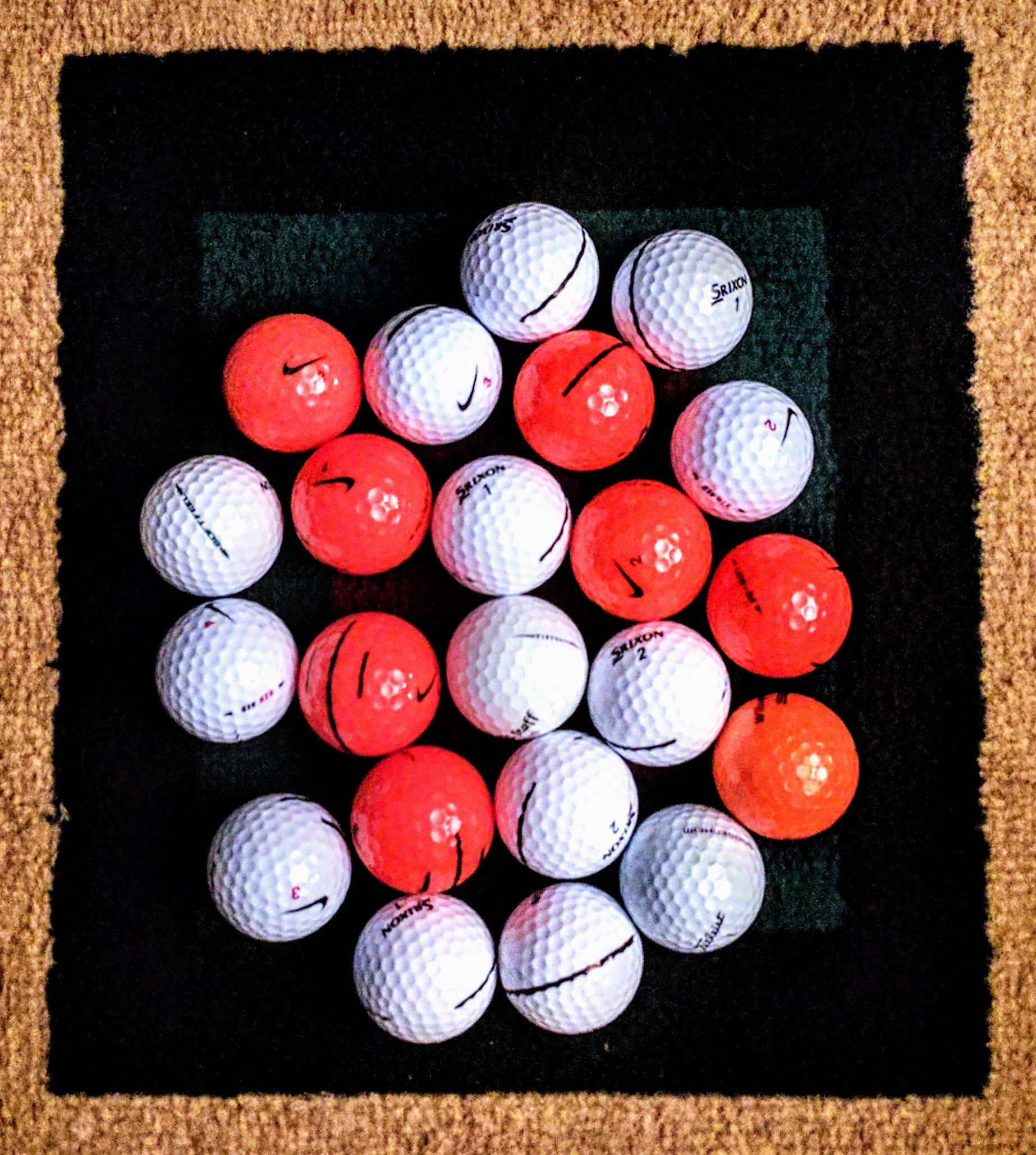Statistical Surprise
When I started looking for my first set of Irons I placed additional importance on three specific categories. I had been practicing my swing at the Range with a friend’s old 5 Iron, and 7 Iron. I was hitting the 5 Iron only about 130 yards, and the 7 Iron about 100 yards on a good day. My miss was usually a slice, or catching it thin. When I didn’t get centre face contact the ball practically flew half the distance. So when I decided to buy my first set, Distance, Forgiveness, and Price were the big three for me. After going to my local Golf store at least a dozen times to test clubs in the simulator I narrowed down my choices to three models. In the end I went with a previous generation of the Adams Blue, and purchased the Adams Idea tech V4. It was a demo set so the price was right. It’s also a Hybrid/Iron set so it’s very forgiving. During testing it also appeared to be quite long. It wasn’t until much later that I realized it didn’t actually add any significant distance. It only seemed that way because of how forgiving it was. My swing was so bad during testing that I rarely caught a ball well enough for the distance characteristics to be accurate. If you are in the market for your first set of clubs then I would like to make a suggestion. The three factors I listed should be of importance to you. When testing clubs bring along a friend that’s a significantly better Golfer than you. When you find a few models that feel right, and are forgiving. Have your friend test those same models for distance. They can tell you if they are longer than what they are used to, average, or shorter. As your swing develops the distance characteristics of that club will begin to take affect. There is one more characteristic you should be aware of when selecting your clubs though, and that’s…
Spin
I’ve already begun researching what my next set of Irons will be. This time I will focus on all four characteristics, Price, Distance, Forgiveness, and Spin. The motivation for this article happened when I did a Google search for High Spin Game Improvement Irons, and basically got nothing useful. You would think that with all the Golf equipment reviewers out there, I’d find something? The reality of it is they still focus on the typical three characteristics. Spin is basically overlooked, even though they have the Spin numbers readily available. So how important is Spin? Well it’s important enough that Ball manufacturers consider it one of the top two reasons to select their ball. So much emphasis is placed on a ball’s Spin characteristics that most Golfers look at that first when selecting a ball. Well what good is having a High Spin ball if your Irons don’t impart much Spin on the ball to begin with? What if you are after more Distance, and select a low Spin ball, but your Irons are designed to increase the amount of Spin? These combinations really don’t make sense do they? While the Forgiveness, and Distance determine how well you can hit a ball. The Spin has a far greater affect on how successfully you play the game. As your swing improves, your ability to hold Greens, run through Fairways, or shape your shot is all determined by the Spin. Too often Beginners believe that a ball change will make a significant difference. In some cases it can, but only if their equipment, and swing allows it. By the end of my second Season I had come to realize that Spin is more important to me than Distance. I have around a 140 yard carry with my 7 Iron. That’s really enough for me. I’ve tried clubs that provide me with a carry of 150 yards, but sacrifice Forgiveness and Spin to do so. Thanks but no thanks. I’ll take control over distance any day.
Low Spin Game Improvement Irons
Calloway Big Bertha
– Center of gravity is low and forward.
– has a 360 degree face cup to increase forgiveness.
– falls into the super game improvement category, and is quite chunky to look at.
– one of the three longest Irons tested.
– one of the three least forgiving Irons tested.
Cobra Fly-Z
– Center of gravity is low and back.
– has a speed channel groove for increased forgiveness.
– relatively attractive top line at address
– very easy to get the ball up in the air.
Ping G Max
– Center of gravity is low and back.
– uses COR Eye2 technology for increased distance and forgiveness.
– falls into the super game improvement category, and is quite chunky to look at.
– very dull appearance, but a satisfying sound and feel at impact.
Mid Spin Game Improvement Irons
Mizuno JPX EZ
– Center of gravity is low and back.
– thin sole cavity increases distance and launch.
– gorgeous looking Iron with the top line at address of a larger Players Iron.
– one of the three least forgiving Irons tested.
Taylormade RSi 1
– Center of gravity is low and back.
– uses face slots and a speed pocket to increase distance and forgiveness.
– slightly lower launch than most of the other Irons tested.
– one of the three most forgiving Irons tested.
Nike Vapor Fly
– Center of gravity is center and back.
– hollow body construction to increase forgiveness.
– NexCOR face to increase distance.
– the hollow body construction gives it a mini hybrid appearance. A unique look that won’t appeal to everyone.
High Spin Game Improvement Irons
Cleveland Launcher HB
– Center of gravity is low and way back.
– hybrid/Iron design for greater launch and improved forgiveness.
– falls into the super game improvement category, and is quite chunky to look at.
– the most forgiving Iron tested.
Wilson D300
– Center of gravity is low and back.
– FLX face technology is used to increase distance.
– power holes around the face increase forgiveness.
– despite a relatively thin top line the urethane filled power holes can look odd to some Players.
– the longest of all the Irons tested.
– one of the three most forgiving Irons tested.
Titleist AP1 716
– Center of gravity is low and back.
– 360 degree cavity increases launch and distance.
– toe and heel weighting increases forgiveness.
– very classic looking Iron with a relatively thin top line.
– one of the three longest Irons tested.
– one of the three least forgiving Irons tested.
My Top 3 and Conclusions
First of all it’s important for you to know that “High Spin” is a relative measure. Generally speaking Game Improvement Irons aren’t high spinning Irons. In order to provide the additional forgiveness and Distance, Spin is usually reduced. For the purposes of this study the Spin groups were: 7 Iron backspin
less than 3500 RPM = Low Spin
3500 – 4500 RPM = Mid Spin
more than 4500 RPM = High Spin
You’ll also notice that I include Irons manufactured from 2015 to 2017. Unlike some of the better known Golf reviewers, I am not sent product from manufacturers to review. I test whatever peaks my interest at my local Golf store. Because price is also an important consideration I have a tendency to purchase clearance items. Every Iron listed in this Review can still be found for purchase.
Now with the four factors carefully taken into consideration my Top 3 Irons for a Beginner that’s serious about improving at Golf are:
3rd Place – Nike Vapor Fly
Although the Nike Vapor Fly wasn’t the longest, or the most forgiving. It was relatively easy to hit, forgiving enough on miss hits, and because Nike got out of the equipment market available for a great price. It still generates enough Spin that Beginners will learn to create enough control over the ball as their swing improves. The looks won’t bother a newer Golfer that isn’t used to a traditional blade. For practically half the price of most of the Irons on this list you can’t go wrong.
2nd Place – Taylormade RSi 1
I found the Taylormade RSi 1 to be the easiest Iron to hit. Maybe it’s a result of the Face slots, and Speed Pocket. I really don’t know. One thing is for sure is that the RSi 1 is very forgiving. Distance is good but not great, and it also generates enough Spin to control the ball as your swing improves. The looks should appeal to most Golfers. Even the Face slots serve to frame the ball at address. It’s the oldest model tested, and as such comes in at a very attractive price.
1rst Place – Wilson D300
You read that right, Wilson wins the day. Shows you why you should take the time to test everything. I’ll be honest with you, the looks of the D300 kind of bother me. All those Power Holes make the club look very busy at address. During testing I was so impressed with the performance that I stopped noticing. It was easily the longest of the Irons I tested, very forgiving on miss hits anywhere on the face, and one of the highest spinning Irons tested. The only other Iron that really came close was the Titleist AP1 716 but it fell far short in the Forgiveness category. Not to mention that the D300 Iron set is currently $200 less than the Titleist. That being said it still comes in at around twice the price of the Taylormade or Nike. So depending on your budget it may currently be out of it.
Honorable mention goes to the Titleist AP1 716 Irons. If you are a slightly better Player that has learned how to shape your shot, but still needs added distance? Then the AP1 Irons could be for you.
Honorable mention also goes to the Cleveland Launcher HB Irons. An absolutely great Beginners Iron that provides maximum forgiveness, and a lot of Spin. Very easy to learn with but be prepared to want to upgrade after only a few seasons.
Beginner’s guide to Golf
FOLLOW ME ON TWITTER
http://twitter.com/cobeness
FOLLOW ME ON INSTAGRAM
http://instagram.com/cobesports
FOLLOW ME ON MY WEBSITE
https://cobelife.com
FOLLOW ME ON FACEBOOK
http://www.facebook.com/cobelifegolf







